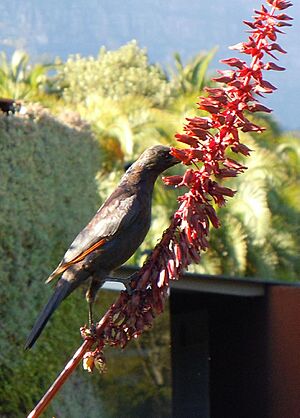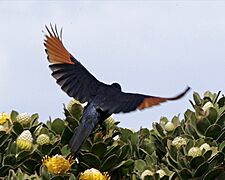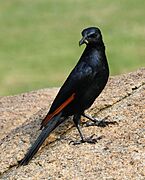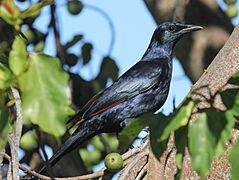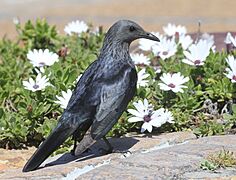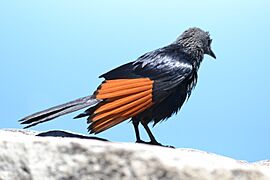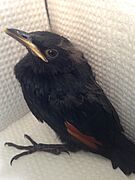Red-winged starling facts for kids
Quick facts for kids Red-winged starling |
|
|---|---|
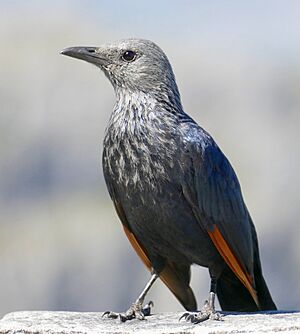 |
|
| Female in Table Mountain National Park | |
| Conservation status | |
| Scientific classification | |
| Genus: |
Onychognathus
|
| Species: |
morio
|
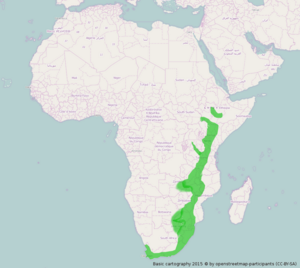 |
|
| native range | |
| Synonyms | |
|
Turdus morio Linnaeus, 1766 |
|
The red-winged starling (Onychognathus morio) is a type of bird from the starling family. It lives in eastern Africa, from Ethiopia all the way down to the Cape in South Africa. This bird eats many different things (it's an omnivore) and can live in many places. It especially likes cliffs and mountains for building its nests. Because tall buildings in cities are similar to cliffs, these starlings have also started living in towns and cities.
Contents
What's in a Name?
In 1766, a Swedish scientist named Carl Linnaeus gave the red-winged starling its first scientific name, Turdus morio. He based this name on earlier descriptions of the bird. The word morio comes from Latin and means "dark brown stone" or "black quartz."
Today, this bird is placed in a different group, or genus, called Onychognathus. This group was created by a German scientist named Gustav Hartlaub in 1849.
There are two main types, or subspecies, of red-winged starlings:
- O. m. rueppellii: Found from southern Sudan to central Ethiopia and northern Kenya.
- O. m. morio (also called the Southern red-winged starling): Found from Uganda and Kenya down to Botswana and southern South Africa.
What Does It Look Like?
This starling is about 27 to 30 centimeters (11 to 12 inches) long.
- The male bird has shiny black feathers. Its flight feathers, which are the ones it uses to fly, are a chestnut (reddish-brown) color. You can see these feathers really well when the bird is flying.
- The female bird has a grey head and upper chest.
- Young starlings look like the males but are not as shiny. Their eyes are brown instead of dark red like the adults.
The red-winged starling makes several whistling sounds. Its most common call sounds like cher-leeeoo.
It can sometimes be hard to tell this starling apart from other similar birds, like its close relative, the pale-winged starling.
- The red-winged starling has reddish-brown flight feathers.
- The pale-winged starling has whitish flight feathers with orange edges.
- The pale-winged starling has bright red or orange eyes, while the red-winged starling's eyes are dark, almost black.
- Only the female red-winged starling has a grey head.
Where Do They Live?
Red-winged starlings live across eastern Africa. Their home range stretches from Ethiopia all the way south to the Cape of Good Hope, KwaZulu-Natal, and Gauteng in South Africa.
These birds can live in many different places. You might find them in:
- Forests
- Savannahs (grassy plains with scattered trees)
- Grasslands
- Wetlands
- Fynbos (a type of shrubland in South Africa)
- Farmlands and tree farms
- Cities and towns
They are now very common in many cities. This is because tall buildings and houses are similar to the cliffs where they originally built their nests. They can also nest in roofs and other openings around homes.
What Do They Eat?
Like other starlings, the red-winged starling is an omnivore, meaning it eats both plants and animals. They eat a wide variety of foods, including:
- Seeds
- Berries
- Nectar from flowers like Aloe and Schotia brachypetala
- Small creatures without backbones (invertebrates), such as beetles
- Sometimes, they even eat baby birds or adult birds of other species, like the African palm swift.
- They will also eat dead animals (carrion) and human food scraps.
When they drink nectar, red-winged starlings choose plants with strong flowers that can hold their weight. Examples include Aloe ferox and Aloe marlothii, and large flowers like those of Strelitzia nicolai.
They also enjoy many kinds of fruit, such as:
- Figs (like the sycamore fig)
- Marulas
- Date palm fruit
- Berries from wild olive trees and Euphorbia plants
- Commercial fruits like apples, grapes, and citruses.
In the countryside, you might see red-winged starlings perching on farm animals and wild animals like cattle, klipspringers, and giraffes. They pick off insects and ticks from these animals, much like oxpeckers do.
Raising a Family
When they are nesting, red-winged starlings can be very protective of their territory. They might act aggressively towards other birds, pets, and even people who get too close to their nests. However, when they are not nesting, these starlings like to gather in large groups with other starlings.
These birds build their nests on rocky cliffs, outcrops, and in gorges. They make a nest out of grass and twigs, with a base of mud, on a natural rock ledge or a building ledge.
- They usually lay three blue eggs, which have red-brown spots. They can lay two to four eggs.
- The female bird sits on the eggs (incubates them) for 13 to 14 days.
- The young birds stay in the nest for another 22 to 28 days before they are ready to fly (fledge).
- Red-winged starlings often raise two sets of babies in one breeding season.
- Sometimes, another bird called the great spotted cuckoo will lay its eggs in the starling's nest, and the starlings will raise the cuckoo chicks.
Who Hunts the Red-winged Starling?
Other birds hunt and eat red-winged starlings. These predators include:
- Peregrine falcons
- Lanner falcons
- Tawny eagles
- Cape eagle-owls
- Pied crows
- Gymnogene (also known as the African harrier-hawk)
Are They Endangered?
The red-winged starling is not an endangered species. In fact, in some places, they can become a bit of a nuisance. They might raid fruit orchards or attack people who get too close to their nests.
Images for kids



